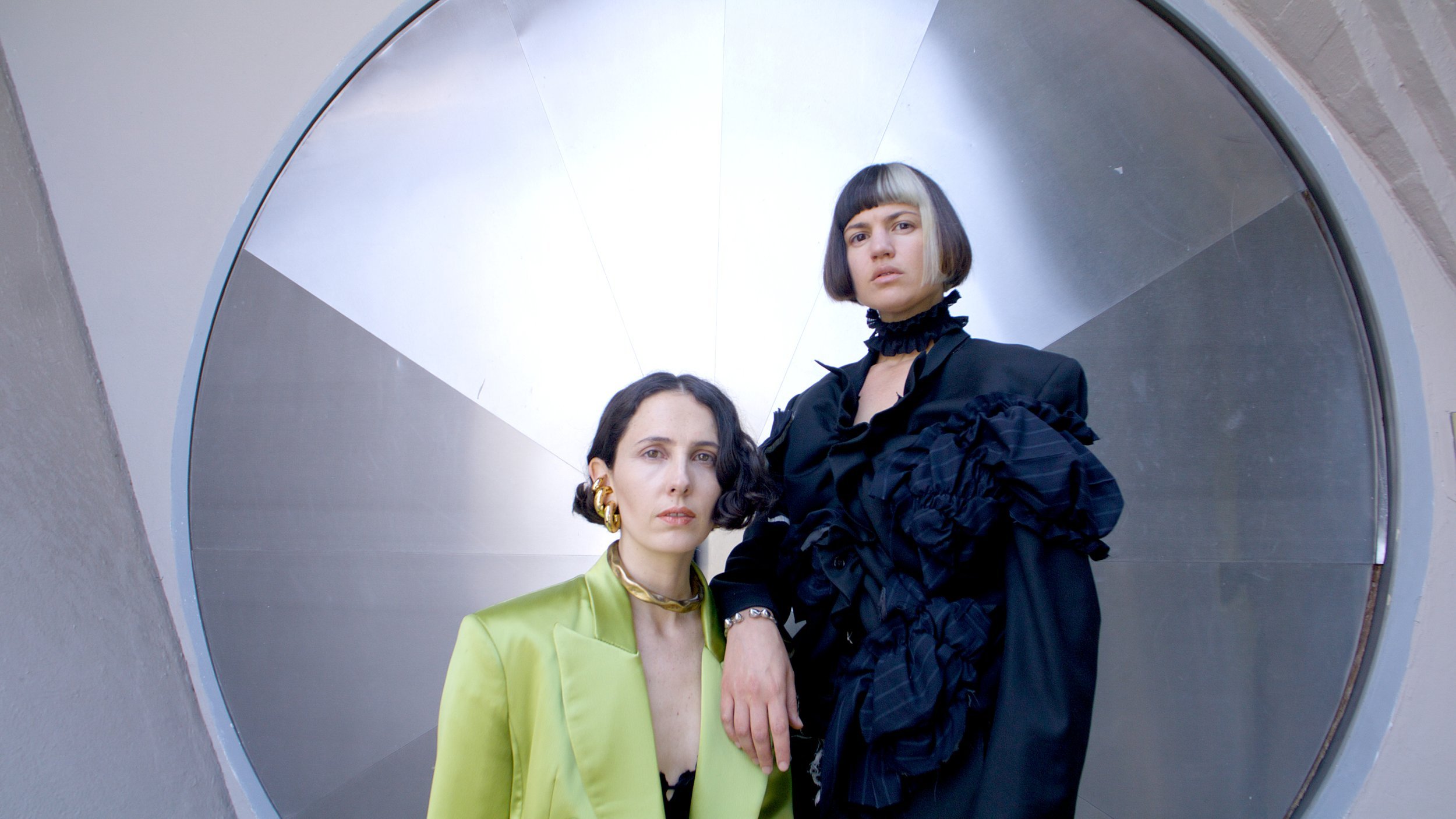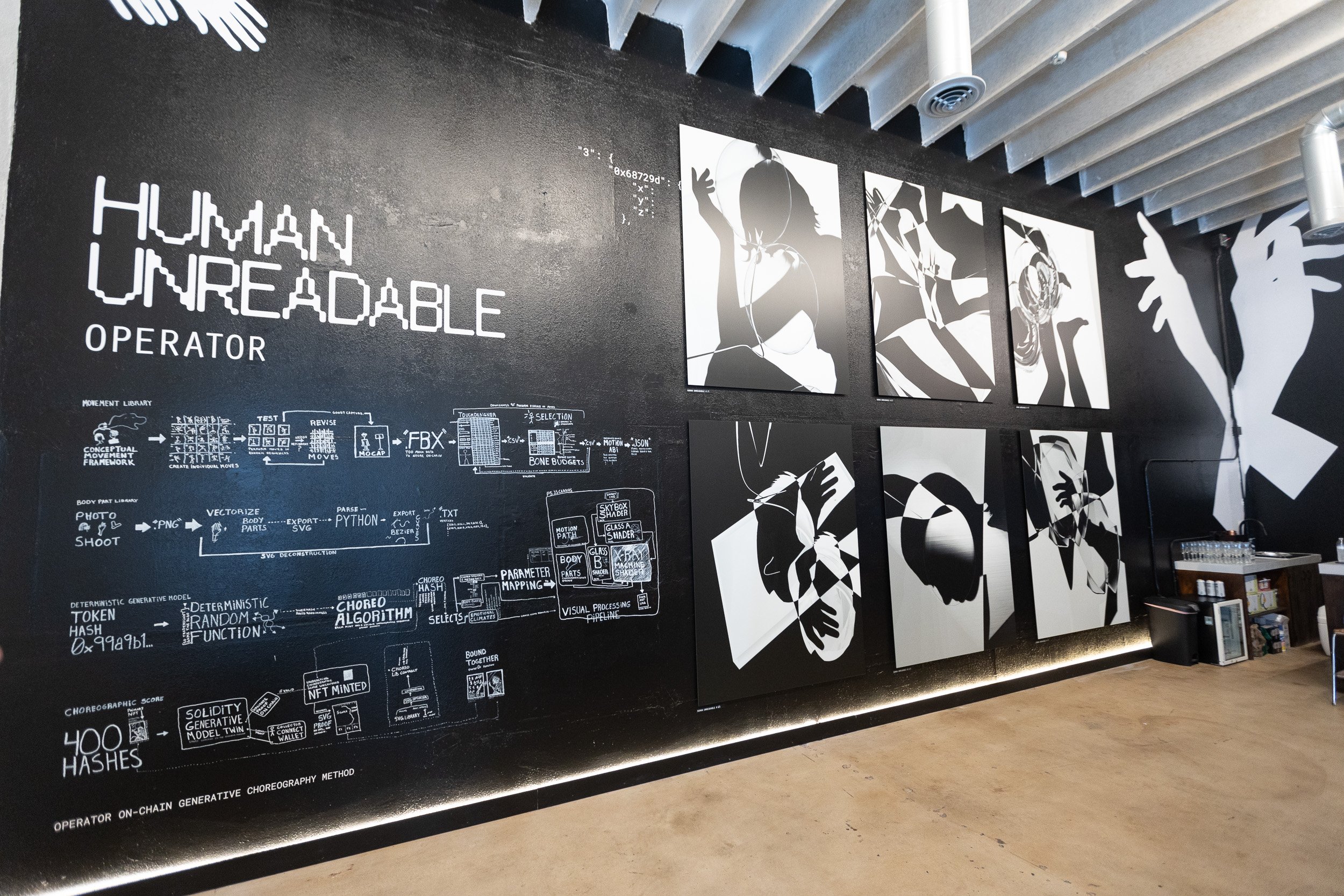Operator’s Human Unreadable Gets IRL PROOF of Concept at Art Basel Miami
The installation showcased elements from all three acts of the immersive work

While Art Basel has long been synonymous with traditional art, the annual art fair—now spanning across Switzerland, Miami Beach, Hong Kong and Paris—has slowly incorporated digital art into its repertoire. With the advent of blockchain technology and surge in digital artwork, Art Basel has become a helpful ally to many in the web3 world.
Helping push the boundaries of the digital art landscape is PROOF, a web3 community that creates real life events and immersive experiences for art collectors to connect with artists, like BEEPLE and Operator, the experiential duo of Ania Catherine and Dejha Ti.
“For us at PROOF, it’s really about identifying artists who are working in deeply conceptual ways, but who are able to express those ideas—and the questions they’re asking—in quite relatable terms,” Eli Scheinman, head of art at PROOF, said to me in a recent conversation. “Someone who is quite foreign to the questions the artist may be asking can enter a space and feel immersed in the environment in such a way that when they ultimately leave, they’re left with new questions for themselves or are left feeling inspired by something within themselves.”
At 2023 Art Basel Miami, Foundry by PROOF teamed with Lumen Prize winning artist Operator to help showcase their Human Unreadable installation launched earlier this year with Art Blocks. The project is a three-act generative artwork that combines choreography, code, blockchain, cryptography and culminates with a live performance.
For act one, 400 pieces in the collection were released on Art Blocks, each driven by the motion data of its underlying unique, on-chain choreographic sequence. For act two, holders of a Human Unreadable nonfungible token (NFT) were able to mint the underlying choreographic score that corresponds to their specific NFT. For act 3, a performance comprised of the sequences behind minted works #2 through #101 (the first 100) will be performed during an in real life (IRL) premiere.
PROOF’s showcase of Operator’s work helped generate more eyeballs on their project and provided attendees with an overall snapshot of the project—blending the digital and physical worlds in a unique way. The ultimate goal was to express the “slow recovery of the human.” In this way, Operator has created circuitry within an art project that swirls the digital and physical elements into one unique work—a work that is part of their larger Privacy Collection.
“What I think we did with PROOF was showcase elements of the work and the choreography method that it took to create the piece,” Ti said to me in a recent conversation. “The exhibition was a natural and physical way to tell the story. Not only did you see the outputs on the wall, you saw a hand drawn method that took us nine months to develop. When you look at the outputs, you don’t think all of this work is underneath. The motion library, the avatars moving, and the stick-figures on this interactive choreography deck helped people decipher all of the different choreography sequences in a collection of 400. It was a way to show a very digital work in a fully organic way and for people to understand what generative choreography means.”
Catherine’s background is in choreography and performance, while Ti comes from the world of human-computer interaction (HCI) technology and immersive art. The duo integrated blockchain into their practice at the end of 2021 after many years of working with different technologies.
“As experimental artists, we wanted to figure out a way to naturally integrate blockchain into what we do,” Catherine said. “We eventually figured out a way with the token as an experiential interface, and figured out how digital scarcity could be introduced to performance. It was bringing the body and physicality to crypto art that we felt was missing from that larger picture.”
For Operator, performance is a strong use case for art forms that couldn’t be monetized before but are now able to be transacted and part of the art market in new ways.
“2022 is when The Privacy Collection started—a multi-lot series of which Human Unreadable is a part—which specifically looks at how privacy functions in a web3 context and the tension and challenge between privacy and transparency,” Ti said. “It’s very much ‘site specific’ to crypto culture and blockchain technology in being known for being unknown and hiding within transparency systems.”
In addition to 2022 being the launch of The Privacy Collection, It also marked the first time Operator sold anything.
“We’d lived off commissions until that time period because we were never interested in creating or selling flat art or changing our medium,” Ti said. “Blockchain technology became a way for us to take what is normally the audience participant in our works and create an interface to remain connected to the collector, aka, audience participant.”
Catherine and Ti then asked how their medium, message, privacy and transparency questions and the human body could translate into a longform generative artwork, while making it all fit into an Art Blocks drop.
“We embarked knowing it would be challenging, not realizing just how much technology was not there to support what we were trying to do,” Catherine said. “We were literally taking motion data and storing choreography on-chain, generating choreographic sequences on-chain, and were figuring out ways for motion data to drive all the visual parameters of the outputs and how all of that becomes an experience for the collector.”
But Operator kept coming up against gaps and was faced with the option to either stop what they were doing or create what they needed in order to keep going. They had to deal with both the limitations and capabilities of the human body as well as the limitations and capabilities of blockchain technology. Those two elements became the constraints in which the duo had to develop Human Unreadable.
“Three seconds of simple human movement captured as motion data is an excel sheet of at least one thousand rows and columns,” Ti said. “That’s very telling of how advanced human technology is, even though we consider it to be primitive. But then you take something that we look at as ‘hi-tech’ and it’s hard to do these very ‘low-tech,’ analog things. It’s interesting to see where advanced technology actually exists.”
The cost to put the human movement library of Human Unreadable on-chain was just over $200,000, so Operator began a process in which they needed to make the data cheaper while still preserving the essence of the moves to lower the cost.
“Everything is stored on-chain and we couldn’t reference an external library, so we really had to get the cost down to something reasonable,” Ti said.
Putting the choreography on-chain took nine months, so Operator is releasing a whitepaper on the set of tools they created to accomplish their on-chain choreography method. They also open-sourced every tool they developed so that other artists and engineers can build off their work.
“The value we discovered was that choreography became a collectible,” Ti said. “Dance and performance was not part of the art market because of the practical reason that it couldn’t be transacted. But for Human Unreadable, the motion data’s unique sequence drives the visual output of the work so the collector actually owns the choreography stored on-chain. It’s verifiably there, provable and deterministic—just like the visual output is.”
In this way, Operator is taking something intrinsically human in choreography, putting it through the digital on-chain mechanisms, only to boomerang it back to something inherently human through performance.
“The performance is going to be open to the public,” Catherine said. “If you own one of the sequences that’s in the performance, there’s going to be an access aspect where you’re prioritized, but what’s been really rewarding and interesting is how the element of ownership has become an entry point for collectors feeling involved and developing a taste for choreography. For us, the introduction of ownership is the very beginning of hopefully having a new audience that’s interested in appreciating movement and performative art.”
While most NFT projects link to the physical world through some sort of utility or physical activation, the way Operator is linking blockchain to the physical world is far more enmeshed. Both worlds—digital and physical—not only coexist to further each other, but are two worlds uniquely intertwined to create a final art product that is as complex under the hood as the sum of its parts, which is what makes Human Unreadable uniquely human.
Correction 1/9/24: Updates to correct term human-computer interaction (HCI)
lead image: Ania Catherine (L) and Dejha Ti


